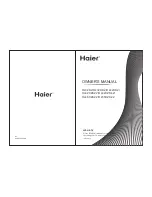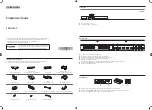
Circuit Descriptions, Abbreviation List, and IC Data Sheets
9.
Standby: The STANDBY line (active “low”) comes from the
microprocessor and pulls the gate of FET 7900 to ground when
activated. This will block the FET. Directly after this FET, a fuse
(1903) is located.
Power down: When the DC voltage from the external adapter
drops below a certain value, the POWER_DOWN line will
inform this to the microprocessor (active "low").
9.4
Input/Output
The I/O is divided over two parts: Rear I/O and Side I/O. The
rear has two SCART inputs, a PC (VGA) input, and a HD
(YPbPr) input. The side has only a SVHS input.
EXT1: The input of SCART1 is CVBS + RGB + L/R and the
output is the video (+ sound) signal from the tuner
(CVBS_TER_OUT).
EXT2: The input of SCART2 is Y/C + CVBS + L/R. The output
signal is CVBS_SC2_MON_OUT (+ sound).
SCART2 is meant for VCR and has therefore some additional
signals in relation to EXT1 but no RGB: it has the possibility for
Y/C_in and Easylink-Plus (P50): Y_in on pin 20 and Chroma_in
on pin 15.
Easylink is handled via pin 10 of the SCART2 (this is a bi-
directional communication with the microprocessor) and
supports the next features:
•
Signal quality and aspect ratio matching
•
One touch play & text
•
PIP
•
Pre-set download
•
WYSIWYR
•
Automatic Standby
•
Country and language installation
•
System Standby
•
Intelligent set top box features
•
NexTView download
•
Timer record control
•
VCR control feature
The selection of the external I/O's is controlled by the Painter
microprocessor (pins 16 & 55) and handled via IC7401:
•
SEL-MAIN-R1R2 is the selection between SCART1 (R1)
and SCART2 (R2).
•
SEL-FRNT-RR selection is made between Side and Rear
I/O.
The status signals (on SCART pin 8) and Front detection are
fed to the Painter (pins 2, 4 and 6).
PC (VGA) in: This input is directly going to the Scaler board.
See paragraph “Video: Scaler Board”.
HD (YPbPr) in: This input is directly going to the Scaler board.
See paragraph “Video: Scaler Board”.
9.5
Tuner and IF
9.5.1
Tuner (diagram A3, A4, and A5)
A Philips UR1336MK3 Tuner with second input (for FM Radio)
is used in the TV board. The SIF FM signal is decoded by the
Micronas IC.
The tuner is I2C controlled, and is capable of receiving off-air,
S- (cable) and Hyperband channels channels.
Tuning is done via I2C. The reference voltage on pin 9 is 7.1 V.
This voltage is derived from the +5 V via a DC/DC converter.
Video IF amplifier
The IF-filter is integrated in a SAW (Surface Acoustic Wave)
filter. One for filtering IF-video (1452, or 1453 in case of system
L/L') and one for IF-audio (1454). The type of these filters is
depending of the standard(s) that has to be received.
The output of the tuner is controlled via an IF-amplifier with
AGC-control. This is a voltage feedback from pin 7 of the
BOCMA to pin 1 of the tuner. The AGC-detector operates on
top sync and top white level. AGC take-over point is adjusted
via the service alignment mode ’Tuner' - 'AGC’. If there is too
much noise in the picture, then it could be that the AGC setting
is wrong. The AGC-setting could also be mis-aligned if the
picture deforms with perfect signal; the IF-amplifier amplifies
too much.
An (alignment free) PLL carrier regenerator with an internal
VCO demodulates the video signal. This VCO is calibrated by
means of a digital control circuit, which uses the clock
frequency of the microprocessor as a reference. The frequency
setting for the various standards is realised via the I2C-bus.
The AFC output is generated by the digital control circuit of the
IF-PLL demodulator and can be read via the I2C-bus.
The video identification circuit is used to identify the selected
CBVS or Y/C signal. The IC contains a "group delay correction"
circuit, which can be switched between the BG and a flat group
delay response characteristic. This has the advantage that in
multi-standard receivers no compromise has to be made for the
choice of the SAW filter. Also, the sound trap is integrated. The
centre frequency of the trap can be switched via the I2C-bus.
The signal is available on pin 27.
QSS sound circuit
The single reference QSS mixer is realised by a multiplier. In
this multiplier, the SIF signal is converted to the intercarrier
frequency by mixing it with the regenerated picture carrier from
the VCO. The mixer output signal is supplied to the output via
a high-pass filter for attenuation of the residual video signals.
With this system, a high performance hi-fi stereo sound
processing can be achieved.
The AM sound demodulator is realised by a multiplier. The
modulated sound IF signal is multiplied in phase with the
limited SIF signal. The demodulator output signal is supplied to
the output via a low-pass filter for attenuation of the carrier
harmonics. The AM signal is supplied to the output (pin 27) via
the volume control.
















































